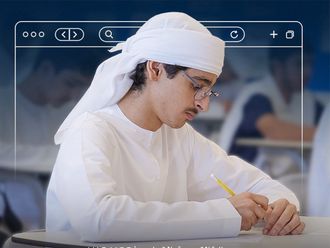Technological advancements in information and communication technology (ICT) have brought about a sea change in education, creating new types of learners, new processes of learning and new approaches to evaluation of that learnt content.
These changes have revolutionised the role of teachers from knowledge disseminators to knowledge facilitators, forcing them to acquire ICT skills to cope with the emerging challenges of an increasingly technology-driven learning environment.
Changes in media and technology enable today's students to stay constantly connected to the internet and social media. This impacts their learning within and outside the classroom.
Engaging students
Research has shown that technology can help improve teaching and learning when used wisely, and ICT companies have responded in kind, creating a mind-boggling array of hardware, software, and devices that give teachers new ways to engage students and improve retention, making learning more interactive and stimulating.
Maya T. Prabhu, Assistant Editor of eSchool News in her article Technology Adds to Students' Math Comprehension, says, "Recent studies from two different continents point to the value of education technology in helping students grasp important yet abstract math concepts — and in both studies, animations that allow students to visualise these concepts were central to the results".
In one research project, the use of interactive whiteboards to teach mathematics in several schools in Great Britain was found to have a positive effect on student learning, according to a three-year study conducted by researchers at Lancaster University.
In the other project, software that takes a visual approach to teaching maths contributed to double-digit gains in the test scores of several Orange County, California, elementary students. "Moving imagery was clearly a key means for [students] to ‘see what is meant', rather than their trying to ‘imagine what is meant' when it is just described by teachers," the report found.
Students were not the only ones affected by using the whiteboard technology; many teachers reported that their approach to instruction shifted as well. Some teachers felt the resources enabled a more collaborative environment to emerge, where they were working with students to construct problems and devise methods to solve them, the study found.
Jamsheed Cooper, an International Baccalaureate student from Emirates International School, concurs that ICT has positively impacted assimilation of key concepts and retention. "I have teachers who use software to explain concepts and power point presentations to share key points for each lesson. As this is posted on the web, it is easily accessible not only in school but also from home, so revision can be at my pace and as per my convenience." Komal Chandiramani, a special educator in the same school, says, "The use of ICT is essential for students with learning difficulties. It enables them to practise skills in a play-way method, allowing repetitions to aid learning. It offers multi-sensory and interesting ways of learning."
A tool for teachers
In his article, R2D2: A Model for Using Technology in Education, Curtis J. Bonk states, "‘Read, Reflect, Display, and Do' can help instructors leverage the internet's potential to help students learn". It was written with college-level instructors in mind, but it's just as applicable to secondary-school classrooms.
Bonk says, "While some look at it as a learning-style model, it is intended as a problem-solving wheel that represents phases of learning — from reading and exploration, to reflective writing, to visualisation of the content learned, to attempts to try it out. R2D2 is also a means to help instructors consider diverse learner needs. At its core, it is also a tool for reflecting on one's teaching practices."
ICT has also enabled learning through multiple intelligence as it has introduced learning through simulation games; it enables active learning through all the senses, catering to needs of students with differing learning styles.
Many view technology as simultaneously a transformative tool for teaching and learning and one that should not be overly depended on. The ever-growing stream of new technologies since the start of the millennium can make the traditional teacher, unused to modern technology, both apprehensive and inadequate. But unless teachers keep pace with this increasingly technology-driven world, they will be inadequately preparing students for this knowledge-intensive world that is interdependent.
"School leaders must understand the power of technology and support continuous learning by teachers," says Dr Don Knezek, CEO, International Society for Technology in Education (ISTE). "Teachers are hungry to learn how technology can engage students and give them authentic experiences for learning. Innovation at the heart of learning is important. Students should use the communication tools in their ‘real lives' as well as in learning."
The UAE ranked first among the Arab states in the 2009-10 Networked Readiness Index (NRI) study issued by the World Economic Forum and 23rd among all 133 countries assessed. The NRI measures the capacity of an economy to fully leverage ICT for increased competitiveness and development.
According to the UAE ICT survey report 2008, every higher educational establishment surveyed has some form of internet connection, with DSL being the most popular type of connection. For example 98 per cent have a computer laboratory and the average number of computers in laboratories in each establishment is 280. Ninety-seven per cent of higher education students use the internet at the establishment, and 98 per cent of the teachers have been trained to use ICT for instructional purposes.
Teaching in private schools in the UAE is being complemented by smartboards, content creation and resource finding via internet tools and better connectivity with students, parents and peers through collaborative learning platforms.
In public schools however, teaching still remains more textbook-driven. The Ministry of Education's educational reforms need to trickle down to every classroom as teachers are entrusted the task of equipping students with the right skills for tomorrow.
Empowering teachers
Workshops that empower teachers to use ICT tools to adopt innovative pedagogical practices to create an improved teaching and learning environment, to encourage students' active participation in academic activities and to acquire appropriate skills are the need of the hour. To help teachers become more comfortable with collaborative learning, all teacher professional development programmes must incorporate information on 21st century tools as well as collaborative work groups.
"In 2011, ISTE will be hosting a huge exhibition called ISTE 2011 Philadelphia from June 26-29. This will be the perfect platform to learn about the latest tools and equipment from around the world," says Lynn Nolan, Senior Strategic Initiatives officer, ISTE.
ICT is here to stay and with it we all become lifelong learners… both the teacher and the taught.
Learn English pronunciation with new British Council iPad app
Learners of English now have a new digital tool to help them master the sounds of the language.
Sounds Right is the first British Council interactive pronunciation chart. It is available free from iTunes as an iPad app. The application groups sounds by vowels, consonants and diphthongs and has examples of each in use.
"About six years ago I developed an interactive LearnEnglish pronunciation chart to enable teachers in class to model the sounds of the English language and help learners with pronunciation," says Mark Hamilton, Research and Development Consultant, British Council. "During this time the application has been used in British Council Teaching Centres in more than 100 countries but we were unable to give it to learners to help with practising pronunciation outside the classroom."
Now this new application joins a growing number of British Council applications available for English language learners and teachers on Android-supported phones, iPhone and iPod Touch. The applications are part of the British Council's LearnEnglish family of learning and teaching materials available free from http://learnenglish.britishcouncil.org/en.
— Gulf News Report













